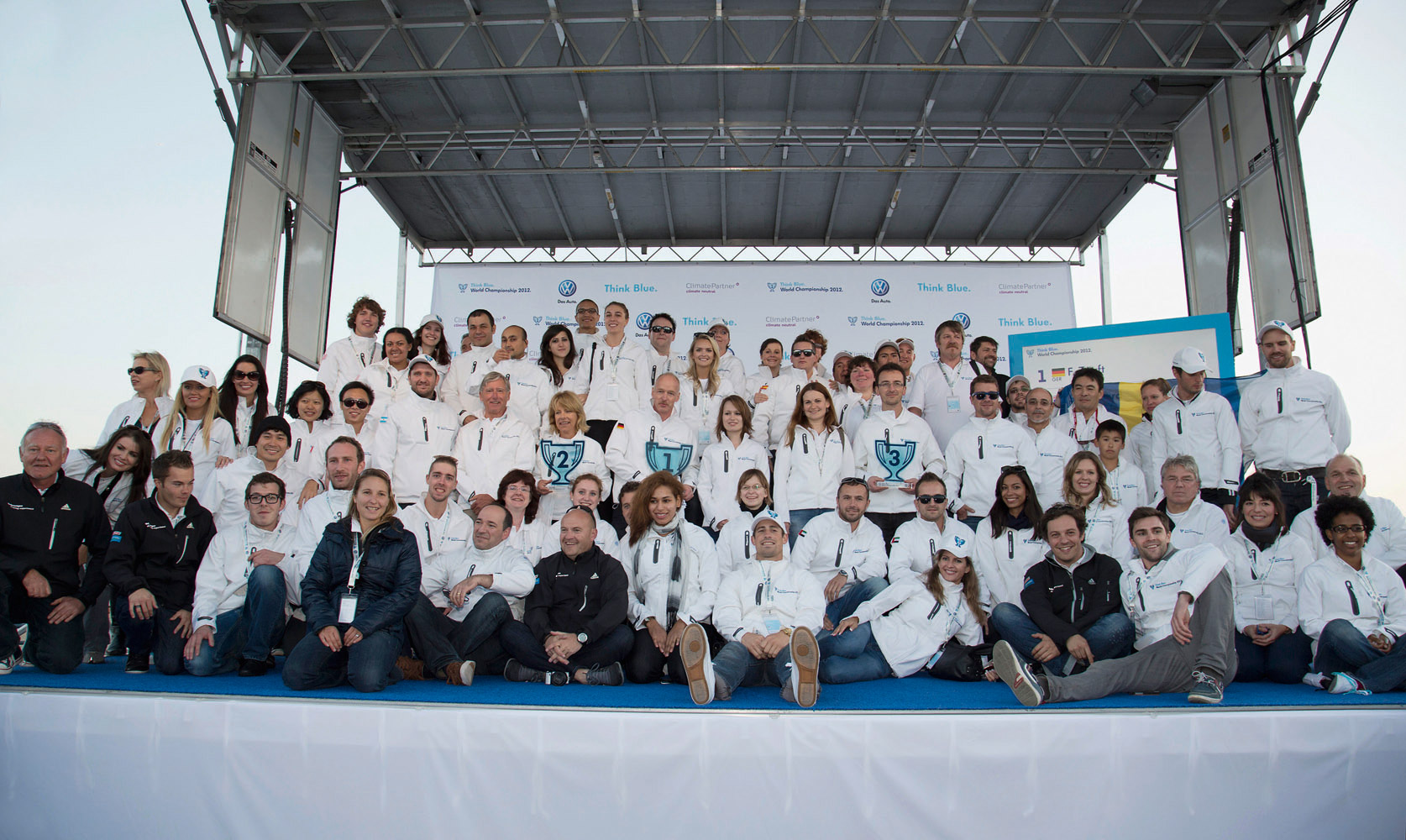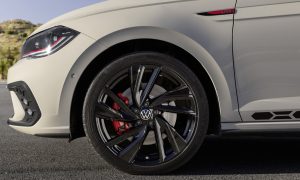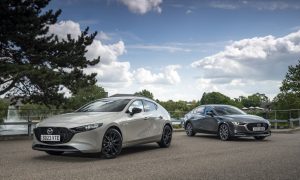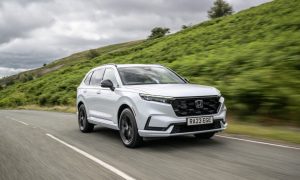
Volkswagen of America is now launching one of the world’s most efficient automobiles on the market: the new Jetta Hybrid. It is powered by a high-tech turbo petrol engine (TSI with 110 kW / 150 PS) and a zero-emissions electric motor (20 kW) working in a fuel-efficient and environmentally friendly alliance. Power transmission is managed by one of the most advanced and efficient automatic gearboxes: the 7-speed DSG from Volkswagen. While this hybrid drive enables very impressive driving performance (0-60 mph in less than 9 seconds), the new Jetta Hybrid also produces an extremely low (combined) fuel economy value of 45 mpg*. This means that the sporty saloon consumes about 20 per cent less fuel than a comparably powered car with a conventional drive system.
At the press of a button, the driver can also choose to drive the new Jetta Hybrid in pure electric mode, and therefore with zero emissions, at speeds of up to 44 mph and over a distance of 1.3 miles (depending on terrain and operating conditions).
Extremely quiet. After the Touareg Hybrid, the Jetta Hybrid is now the second model from Europe’s most successful carmaker to have a drive module under the bonnet containing a petrol engine and an electric motor that are paired to attain the lowest possible fuel consumption values and excellent performance in all areas. Consider its comfort: in combination, the refined TSI, a newly designed exhaust system, use of an acoustic windshield, thicker side windows in front and various other measures have resulted in the quietest car Volkswagen has ever offered in this class.
TSI is one of the world’s most advanced turbo petrol engines
Pure efficiency. For the first time in America, Volkswagen is using a 1.4-litre turbo petrol engine in the Jetta Hybrid. The TSI engines from Volkswagen have won various awards, including one of the world’s most prestigious in this field: the “Engine of the Year Award” for 2011.
Practice proven on the German Autobahn. The downsized four-cylinder with a displacement of exactly 1,395 cc – millions of units of this engine have already sold in Europe – develops a torque of 250 Nm at just over the idling speed (from 1,400 rpm) and is extremely durable even at German Autobahn speeds. The maximum power of this TSI even surpasses that of the 2.5-litre five-cylinder engine in the conventionally powered Jetta. The highlight is that the remarkably quiet TSI can maintain this constant high maximum torque up to 3,500 rpm. Together with the electric motor, the drive system exhibits performance characteristics that make the new Jetta Hybrid a sporty cruiser. Incidentally, the TSI is a lightweight unit weighing 98 kg.
TSI, decoupling clutch and E-motor form the hybrid module
High-tech alliance. The TSI, the electric motor and a decoupling clutch form the hybrid module. This is integrated between the two drives and fully disengages the petrol engine from the drivetrain when in pure electric driving mode or ‘sailing’ mode (coasting / braking).
State-of-the-art battery technology. A lithiumion battery supplies the energy for driving the electric motor. The compact battery system is integrated behind the rear bench seat. The results: no compromises whatsoever in interior space. The battery is constructed of 60 individual cells, each with an energy capacity of 5 Ah; altogether, they produce a nominal voltage of 220 Volt and an energy capacity of 1.1 kWh. Weight: 35.8 kg. The frequent alternation of discharging and charging cycles in hybrid operation requires high-performance battery cooling, which in this case is handled by a fan mounted directly on the energy storage device. The battery also has its own management system that performs safety, diagnostic and monitoring functions as well as temperature management. Need-based control of the fan (as a function of such factors as outside temperature and momentary power demand) ensures that the battery continually operates within an optimal temperature window. Special protection systems also electrically disconnect the battery when not in use or in case of a crash.
Fast dual-clutch gearbox. Power transfer to the driven front axle is managed by a 7-speed dual clutch gearbox (DSG) that operates quickly and efficiently; it was developed in Germany and has already revolutionised the market for automatic gearboxes. The combination of a hybrid drive and DSG is unique here, because it merges driving fun with sustainability. The proven 7-speed dual-clutch gearbox sets the benchmark in this torque class – with torques of up to 250 newton meters ? based on its low weight of 74 kg and very compact construction. Thanks to its lightweight drive components, the weight of the Jetta Hybrid was only increased by 100 kg despite the battery system. Together with additional safety modifications to the vehicle structure, the gross weight of the new Jetta Hybrid is still less than 1,500 kg.
The right drive system mode for every situation
Zero emissions driving by electric motor. When the battery of the Jetta Hybrid is sufficiently charged, the Volkswagen can, as mentioned, be driven over a distance of up to 1.3 miles in pure electric mode and therefore with zero emissions. The Jetta Hybrid is switched to electric drive mode either automatically (up to 37 mph) or manually (up to 44 mph) by pressing the E-mode button to the right of the gear shift lever. In both cases, the TSI is disengaged from the drivetrain by a decoupling clutch, which reduces energy consumption and increases electric driving range. About one-third of the fuel-saving potential in the Jetta Hybrid is realised by electric driving.
Battery charging by regeneration. During braking, the Jetta Hybrid switches over to a battery regeneration mode, which ‘captures’ kinetic energy and feeds it into the battery as electrical energy. This is how it works: As soon as the driver releases the gas pedal to brake, the decoupling clutch opens to disengage the engine and reduce drag torque losses in this phase. If the driver now activates the brake pedal, the generating power of the electric motor increases – as a function of brake pedal travel – and the electrical energy produced in this way is stored in the battery. The stored energy is then available, either for electric driving or boosting. The effect of battery regeneration should not be underestimated; it represents another third of the fuel-saving potential realised in the Jetta Hybrid!
In city driving the TSI is silent whenever possible. The Volkswagen’s gasoline engine is shut off as soon as the car stops in city or stop-and-go traffic, provided that the driver presses the brake pedal and the battery is sufficiently charged. However, the heating, air conditioning system and electric convenience systems such as the audio system continue to operate. Of special interest here is the fact that, unlike in conventional systems, not only is the Jetta’s petrol engine stopped; the decoupling clutch also disengages the engine from the drivetrain to enable a pure electric driving mode when the car drives off again as an alternative to petrol engine driving – provided that the battery is sufficiently charged. Another third of the fuel-saving potential in the Jetta Hybrid is realised by frequent deactivation of the TSI.
‘Sailing’ without TSI. As soon as the driver releases the accelerator pedal at higher vehicle speeds (up to 84 mph), the TSI is shut off and is also disengaged from the drivetrain via a decoupling clutch to eliminate drag torque losses in this driving situation. As a result, the Jetta Hybrid coasts further than is usual, without consuming any fuel.
Double the power with boosting. If the DSG gear selector is in the ‘S’ gear position or the manual shift gate, the drive system reacts to vigorous accelerator pedal travel with maximum propulsive power. The same applies to the classic kickdown (a quick press of the accelerator all the way to the floor). In this case, the power of the E-motor and the TSI combine to output a temporary peak power of 125 kW / 170 PS, which is applied to the front wheels via DSG. In automotive jargon, this interplay of engine and motor is known as ‘boosting’. The extra power can be used to complete passing manoeuvres in the shortest of times, which improves active safety.
Driving with the petrol engine. On faster drives and/or when battery capacity is low, the Jetta Hybrid is powered by just the TSI engine. In these phases, the operating point of the TSI is also shifted to optimise efficiency; it delivers more power than is needed for pure propulsion of the Volkswagen. This excess power is utilised in a very specific way: depending on the battery’s momentary charge state, the extra power might be used to charge the high-voltage battery via the electric motor – which in this case acts as a generator. These so-called active charging phases are interspersed with electric driving phases to realise the best possible fuel economy.
Comprehensive information for greater sustainability
New instruments. All relevant operating states are displayed by the instruments of the Jetta Hybrid. The driver calls up information via menus for the new instruments. Under the ‘Hybrid’ menu, the currently active drive mode is displayed in an energy flow diagram, and the direction of energy flow is visualised in the form of arrows. The battery charge state is shown on the same screen. Directly below the energy flow diagram is what is known as the ePower meter. This indicates the relative power of the electric motor. The ePower meter is only active in the ‘electric driving’, ‘E-mode’ and ‘Boost’ operating modes.
Power meter shows power source of hybrid drive. Of central importance is the so-called Power meter (not to be confused with the ePower meter). The Power meter – a multifunctional display that replaces the tachometer and which is integrated on the left side of the instrument cluster – informs the driver of the momentary operating state of the Jetta Hybrid: a general readiness to drive (‘Ready’), battery regeneration (‘Charge’), eco-friendly driving mode (‘Eco’), boosting (‘Boost’) or pure internal combustion engine driving with the TSI (‘Off’). In addition, electric driving – either automatic or manually selected by the driver – is also indicated in the instruments (‘E-mode’).
Playfully visualising how efficiently one is driving. The audio system display plays a role in this information strategy. The goal here is an especially economical mode of driving. To realise this goal, the ‘Zero emissions’ menu offers a graphic display of the car’s driving time with zero emissions. The zero emissions values are shown in the form of per centages in a bar diagram, where the measurement interval of one bar represents one minute of driving. A value of 100 per cent means that the Jetta Hybrid was driven with zero emissions throughout the driving minute, i.e. with the TSI engine shut off. A total time period of 30 minutes is considered.
Extensive safety and convenience features
Electronically stabilised. Standard equipment in the new Jetta Hybrid includes an electronic stabilisation programme (ESP), anti-lock braking system (ABS) and six airbags (driver and front passenger airbags, side airbags in front as well as window airbags, front and rear). This pack can be extended to include rear side airbags as an option.
SE – specified exterior. Visually, even the base version (SE) of the Jetta Hybrid is distinguished by aerodynamic modifications that include a new front spoiler, a rear diffuser and a rear spoiler that is harmoniously integrated into the design. The results: the car’s Cd value was improved by 10 per cent. In addition, the Jetta Hybrid SE is equipped with a new LED rear lights design and special 15-inch alloy wheels with all-season tyres optimised for low rolling resistance. Hybrid signatures on the front, rear and side body panels identify the new drive version. Other distinguishing features: a special radiator grille where the VW logo is integrated on a blue background for the first time. Exclusively reserved for the Jetta Hybrid is the new body paint ‘Oryx white’.
SE – upgraded interior. Inside, the car features high-end seat covers in ‘Titan black’ or ‘EcoTech’ design and new accent strips with the ‘Hybrid’ chrome signature, which identify the car as the Jetta Hybrid SE. A 2-zone automatic climate control system (Climatronic) with a new high-voltage air conditioning compressor ensures that the interior can be cooled even without the petrol engine running. Compared to the Climatronic used to date, this system also has the new ‘maxAC’ function, which cools down the interior very quickly at the press of a button. The technology of the Jetta Hybrid SE was perfected by specific instruments that include an energy flow diagram in the Premium 8 audio system, a trip computer, hands-free telephone system (Bluetooth) and interface for iPod and other multimedia sources as well as a multifunction leather-wrapped steering wheel.
SEL1 and SEL2 are high-end. In the mid-level equipment version, the SEL1, standard features of the new Volkswagen are extended with such details as 16-inch alloy wheels, a tilt/slide glass sunroof, RNS 315 navigation system, electric driver’s seat adjustment, seat heating in front, and the Keyless Access system for door locking and engine starting via a Start button. Customers who order the top version, the SEL2, can also enjoy details such as 17-inch alloy wheels, newly developed bi-xenon headlights with dynamic cornering lights and automatic motorway lights, fog lights, reversing camera and a new Fender sound system with 400 Watts of output power. And that is how it should be. After all, who says that maximum sustainability cannot be fun as well?
Notes:
TDI, TSI, DSG and Twincharger are registered trademarks of Volkswagen AG or other companies of the Volkswagen Group in Germany and other countries.
Features and technical data apply to models offered in the USA . They may differ in other countries.
* All fuel economy data on the Jetta Hybrid is based on manufacturer estimates as of November 2012.
Previous article
2014 Jaguar XFR-S



